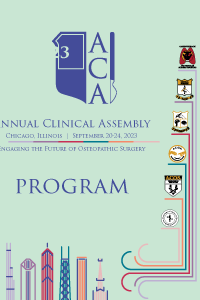General Surgery
Spontaneous Tumor Lysis Syndrome (STLS) in the setting of Burkitt Lymphoma
- JA
Jenna E. Allen
Allegheny Health Network - St Vincent
Erie, Pennsylvania, United States
Primary Presenter(s)
Tumor lysis syndrome is an oncologic phenomenon first described in 1963 when researchers noticed severe kidney injury following the initiation of cytotoxic chemotherapy. Risk factors for the development of TLS include both intrinsic tumor-related and extrinsic patient-related factors. Intrinsic factors include a high proliferation rate of tumor cells, tumor size > 10 cm, WBC count > 50,000, and lactate dehydrogenase (LDH) two times the normal limit. Extrinsic factors include elevated uric acid, elevated creatinine, use of corticosteroids, and intrathecal chemotherapy. Four major metabolic derangements occur in TLS: hyperuricemia, hyperphosphatemia, hyperkalemia, and hypocalcemia. Rapid breakdown and catabolism of purine bases result in hyperuricemia, which overwhelms the normal clearance capacity of the kidneys. Malignant cells are said to have upwards of four times the amount of phosphate as normal cells, and hyperphosphatemia results from the rapid release of intracellular phosphate into the bloodstream. Hypocalcemia directly results from high levels of phosphate, causing calcium-phosphate crystals in the renal tubules. Hyperkalemia results from the release of intracellular potassium from tumor cell lysis and remains the most serious complication of TLS, due to the high risk of cardiac arrhythmia. Interestingly, hyperkalemia remains often the earliest laboratory manifestation, which may prove useful for monitoring patients at risk of developing TLS. The most common manifestation of TLS is the development of acute kidney injury, due to the rapid increase in serum uric acid. Patients with high-risk cancers, large tumor burdens, or undergoing chemotherapy should be closely monitored for rising creatinine or development of nephrolithiasis. It has been proposed that due to the rapid turnover and use of lysed cellular material, STLS may not be evident until overt TLS and multi-organ failure occurs.
Methods or Case Description:
A 54-year-old Caucasian female presented to the emergency department with a three-week history of enlarging right axillary mass with paresthesia in the right hand. She reported that approximately 6 months prior, she noticed swelling about the size of a marble, but the mass spontaneously regressed. Past medical history was significant for hemorrhagic CVA 2 years prior with residual left-sided paresis, hypertension, hyperlipidemia, and type 2 diabetes mellitus. Initial labs in the ER revealed creatinine of 1.47 (baseline 0.6), potassium of 4.2, and high-anion gap metabolic acidosis (bicarbonate of 15, lactic acid 2.9). CT scan revealed a large mass along the right chest wall, within the axillary region measuring up to 14.4 x 16 x 15.1 cm (AP x TR x CC). The lesion abutted to the 2nd-4th lateral rib and involved the latissimus dorsi, serratus anterior, pectoralis major, and minor muscles. Initial differential diagnoses included soft tissue sarcoma, primary breast cancer, or lymphoma. She was admitted for an unidentified axillary mass and acute kidney injury. IVF hydration was initiated overnight, general surgery was consulted for a mass biopsy. Given the patient’s stable status, they recommended outpatient follow-up. Due to worsening creatinine, CT abdomen and pelvis were ordered which revealed bilateral non-obstructive nephrolithiasis, and 5-millimeter obstructive calculus at the ureteropelvic junction. Nephrology and urology were consulted for management. On day 3 of admission, an ultrasound-guided chest wall biopsy was performed, later revealing high-grade B-cell lymphoma. Immunohistochemistry revealed CD-19, CD-20, and CD-10 co-expression. Fluorescence in situ hybridization (FISH) analysis revealed MYC rearrangement, consistent with Burkitt lymphoma.
Outcomes: Four days after admission, labs revealed potassium of 5.3, phosphate 5.6, calcium 7.9 and uric acid of 12, at which time she was diagnosed with spontaneous tumor lysis syndrome. Rasburicase was given to lower uric acid concentration, and she was transferred for a higher level of care. As part of the lymphoma workup, TTE was ordered and revealed global wall hypokinesis previously not seen, reflecting stress or ischemic cardiomyopathy. Cardiology was consulted due to type II N-STEMI, and critical care was consulted due to patient decline. Hemodialysis was initiated eight days after initial admission due to worsening creatinine and clinical decline. Eleven days following patient’s presentation, combination chemotherapy was initiated. Standard chemotherapy for diffuse large B-cell lymphoma is rituximab, cyclophosphamide, doxorubicin, vincristine and prednisone. Given the known cardiac toxicity of doxorubicin, etoposide was given in place (R-CEOP). Initiation of chemotherapy was complicated by a grade two infusion reaction to rituximab. The remaining chemotherapy sessions were done following the dose-adjustment protocol and split dosing of rituximab to reduce side effects and decrease the risk of TLS development. After four rounds of chemotherapy, CT scan showed a significant decrease in the size of the axillary mass. Unfortunately, treatment was complicated by anemia requiring multiple transfusions, and the patient elected to transition to hospice care.
Conclusion:
Burkitt lymphoma (BL) is an aggressive non-Hodgkin lymphoma, with three forms: endemic, sporadic, and immunodeficiency related. Endemic BL is associated with Epstein-Barr virus (EBV) or malaria and classically presents as tumors of the jaw in children. The sporadic form is linked to mutations in the MYC gene and represents 1-2% of lymphomas diagnosed annually in the United States. The primary site of sporadic BL is traditionally in the abdomen, but axillary presentation has been reported in some cases. In patients like this with classically defined “high-risk” malignancies such as Burkitt lymphoma with elevated LDH or diffuse large B-cell lymphoma with bulky disease, prevention of TLS prior to chemotherapy initiation is vital to positive patient outcomes. The mainstay of current TLS treatment is prevention – with aggressive IVF administration, allopurinol, and rasburicase as needed. Spontaneous TLS is a rare oncologic phenomenon that can worsen patient outcomes due to a lack of pre-treatment. Here, our patient presented with many risk factors that increased her risk of TLS: bulky tumor, elevated LDH, and increased creatinine. Even in the absence of a diagnosis of malignant disease, swift recognition and treatment of worsening electrolyte abnormalities and renal damage were essential to prevent multi-organ failure and death.

